| Imperialism in China Printable PDF Outline |
|---|
| www.studenthandouts.com ↣ World History ↣ Imperialism ↣ Imperialism Outlines & PPTs |
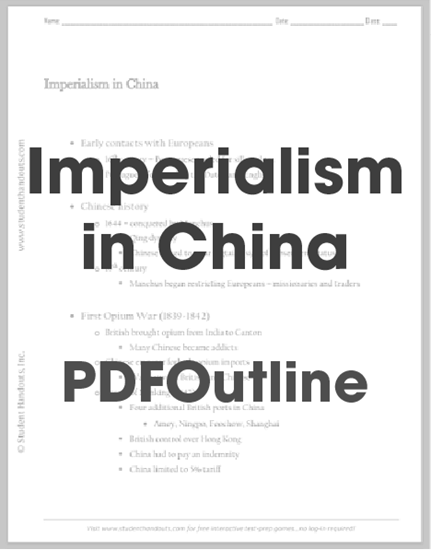 I. Early contacts with Europeans
I. Early contacts with EuropeansA. 16th century—Portuguese traded for silk and tea B. Portuguese followed by the Dutch and English II. Chinese history A. 1644—conquered by Manchus 1. Qing dynasty 2. Chinese forced to wear pigtails (sign of subservient status) B. 18th century 1. Manchus began restricting Europeans—missionaries and traders III. First Opium War (1839-1842) A. British brought opium from India to Canton 1. Many Chinese became addicts B. Chinese emperor forbade opium imports 1. War between British and Chinese C. Treaty of Nanking (1842) 1. Four additional British ports in China a. Amoy, Ningpo, Foochow, Shanghai 2. British control over Hong Kong 3. China had to pay an indemnity 4. China limited to 5% tariff IV. Other Westerners in China A. Belgium, France, Holland (Netherlands), Portugal, Prussia (Germany), United States B. Spheres of influence 1. Exclusive trading areas C. Extraterritoriality 1. Tried in their own courts and under their own laws V. Second Opium War (1856-1860) A. Also known as the Arrow War B. Results 1. More Chinese ports opened up to European trade 2. Opium traffic legalized 3. Protection of Christian missionaries 4. All foreign vessels could navigate the Yangtze River 5. U.S. and Russia also participated in peace process a. Russia's border extended to Amur River i. Maritime Provinces—Pacific area without permafrost ii. Founded Vladivostok in 1860 VI. More foreign control of China A. Annam, etc. 1. Merged into French Indo-China (1883) B. Burma (Myanmar) 1. Annexed by British (1886) C. Formosa 1. Attacked and taken by Japanese (1895) D. Korea 1. Annexed by Japanese (1910) E. Liaotung Peninsula (Manchuria) 1. Concessions to Japanese (1910) VII. Manchuria A. Imperial powers (particularly Japan and Russia) vied for control of the Manchurian Railway B. France, Germany, and Russia coerced Japan to return the Liaotung Peninsula to China VIII. New Scramble for China A. France 1. Kwangchow—99-year lease B. Germany 1. Shantung Peninsula—sphere of influence C. Great Britain 1. Wei-hai-wei—naval base 2. Yangtze valley—sphere of influence D. Russia 1. Liaotung Peninsula—lease 2. Manchuria—economic concessions IX. Boxer Rebellion (1900) A. Chinese people resented foreign influence and power B. Order of the Patriotic Harmonious Fists 1. Called "Boxers" by Westerners 2. Demanded that foreigners leave China 3. Killed circa 300 and vandalized foreign property C. European imperialists, Americans, and Japanese put down the rebellion D. China paid $333,000,000.00 in damages and had to permit military forces in Peking (modern-day Beijing) and Tientsin X. Fall of the Qing (Manchu) dynasty A. Empress Dowager Cixi (1835-1908) 1. De facto Chinese monarch (1861-1908) 2. "Make me unhappy for a day and I will make you unhappy for a lifetime." 3. Conservative and anti-foreign 4. Blamed by many Chinese for foreign imperialist power in China B. Emperor Puyi—the "last emperor" 1. Lived 1906-1967 2. Ruled China 1908-1912, and as a puppet for 12 days in 1917 3. Puppet emperor of Manchukuo (Japanese-ruled Manchuria), 1932-1945 4. Spent ten years in a Soviet prison after WWII 5. Lived a quiet life as a regular citizen in communist China 6. Died of disease during the Cultural Revolution (1967) XI. Republican Revolution A. Sun Yat-sen (a.k.a. Sun Yixian) 1. Founded Kuomintang (Nationalist party) a. Overthrew Manchu (Qing) dynasty b. Established a republic c. President of Chinese Republic that succeeded him—Yuan Shih-k'ai XII. Republic of China—weaknesses A. Disunity 1. Local warlords fought Kuomintang for control 2. Wars raged between 1912 and 1928 B. Foreign imperialists 1. Americans, Europeans, and Japanese C. Poor transportation 1. 1914—only 6,000 miles of railroad track a. 225,000 miles in the smaller United States 2. Few decent roads XIII. Foreign imperialists A. Twenty-One Demands (1915) 1. Japan attempted to make China a Japanese protectorate 2. Action condemned and stopped by other leading world powers B. World War I and the Treaty of Versailles 1. China attempted to abolish concessions and extraterritoriality a. Attempt failed 2. China did not sign the Treaty of Versailles 3. Japan gained mandate over most of Germany's Asian possessions and rights XIV. Three Principles of the People A. Book published by Sun Yat-sen before his death in 1925 1. Principle of Minquan a. Democracy—the people are sovereign 2. Principle of Minzu a. Nationalism—an end to foreign imperialism 3. Principle of Minsheng a. Livelihood—economic development, industrialization, land reform, and social welfare—elements of progressivism and socialism XV. Growth of communism A. Sun Yat-sen appealed for Russian (Soviet) aid following the Versailles Conference 1. 1921-1925—China received advisors, arms, communist propaganda, and loans 2. Russia revoked its imperialist rights in China XVI. The Kuomintang is split A. Right wing 1. Businesspeople 2. Politicians B. Left wing 1. Communists 2. Intellectuals 3. Radicals 4. Students XVII. Nationalist Revolution A. Sun Yat-sen succeeded by Chiang Kai-shek B. Communists expelled by Kuomintang C. 1926-1928—war to control the warlords D. Capital moved from Peiping (a.k.a. Peking, today's Beijing) to Nanking (a.k.a. Nanjing) XVIII. Civil war in China A. 1927-1932 and 1933-1937—war between Communists and Nationalists B. Communists—Mao Tse-tung (Mao Zedong) C. Nationalists—Chiang Kai-shek D. War halted 1932-1933 and 1937-1945 to fight Japanese aggression E. Communists were victorious in 1949 F. Nationalists retreated to Formosa (Taiwan) G. End of imperialism in China 1. Hong Kong returned to China in 1997 XIX. Review questions A. What Chinese goods were sought by European traders? B. What were the consequences of the First and Second Opium Wars? C. Describe the Open Door Policy. D. What was the Boxer Rebellion? E. What were Japan's Twenty-One Demands? F. Describe Sun Yat-sen's three principles. G. What area of China remained under British control until 1997? Click here to print. Click here for a PowerPoint version of this outline. |
 | 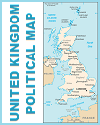 |  | 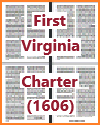 | 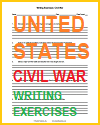 | 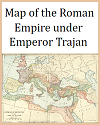 |
| Imperialism Books and Films | Imperialism Outlines and PowerPoints |
| Imperialism Maps and Pictures | Imperialism Study Games |
| Imperialism Miscellany | Imperialism Worksheets |
| www.studenthandouts.com ↣ World History ↣ Imperialism ↣ Imperialism Outlines & PPTs |








